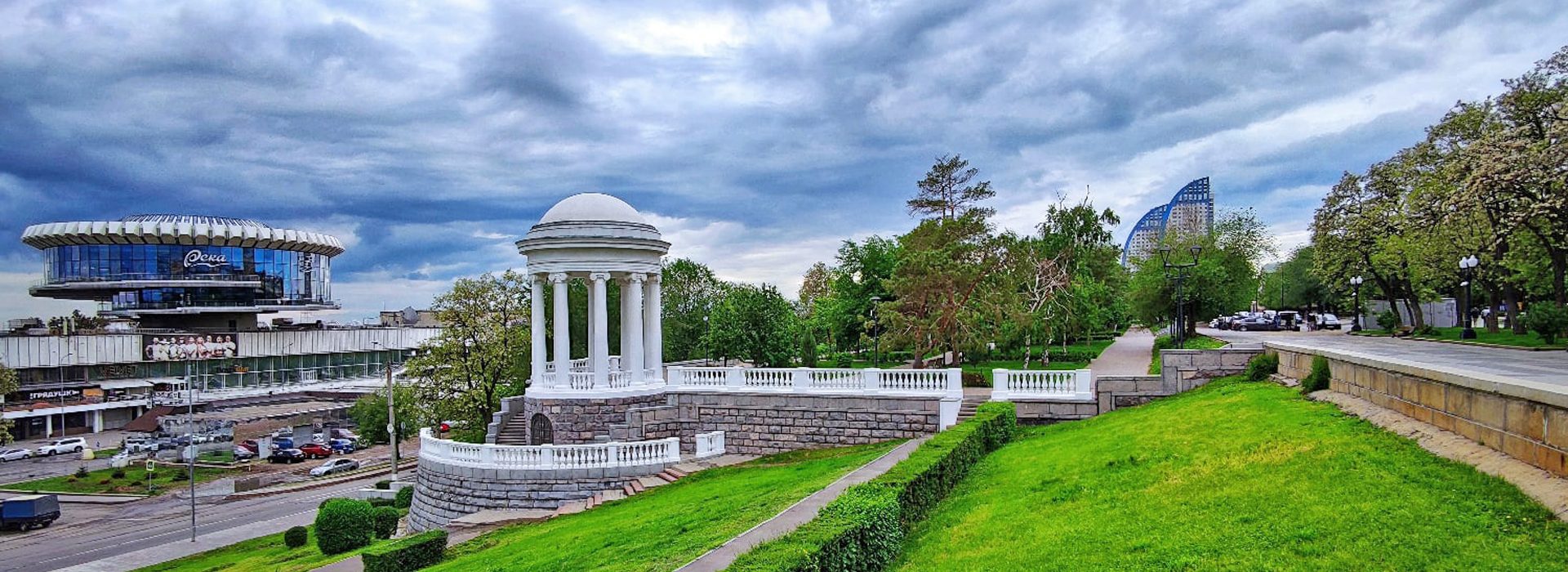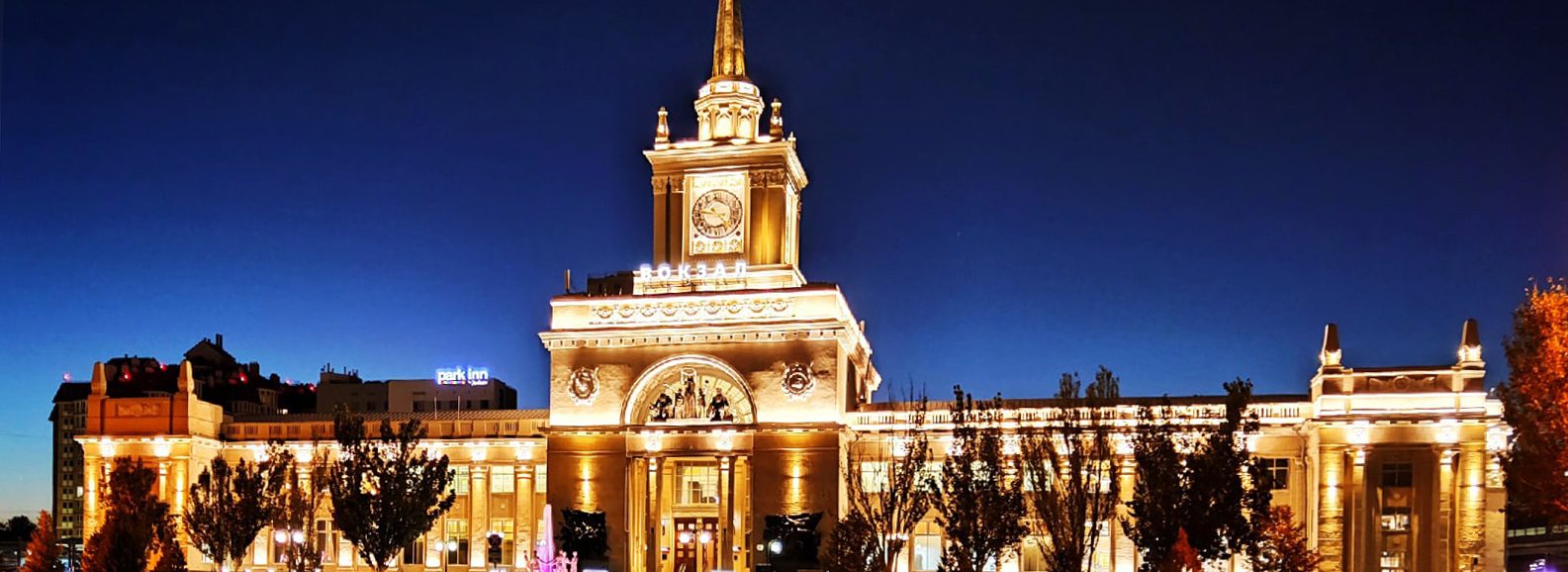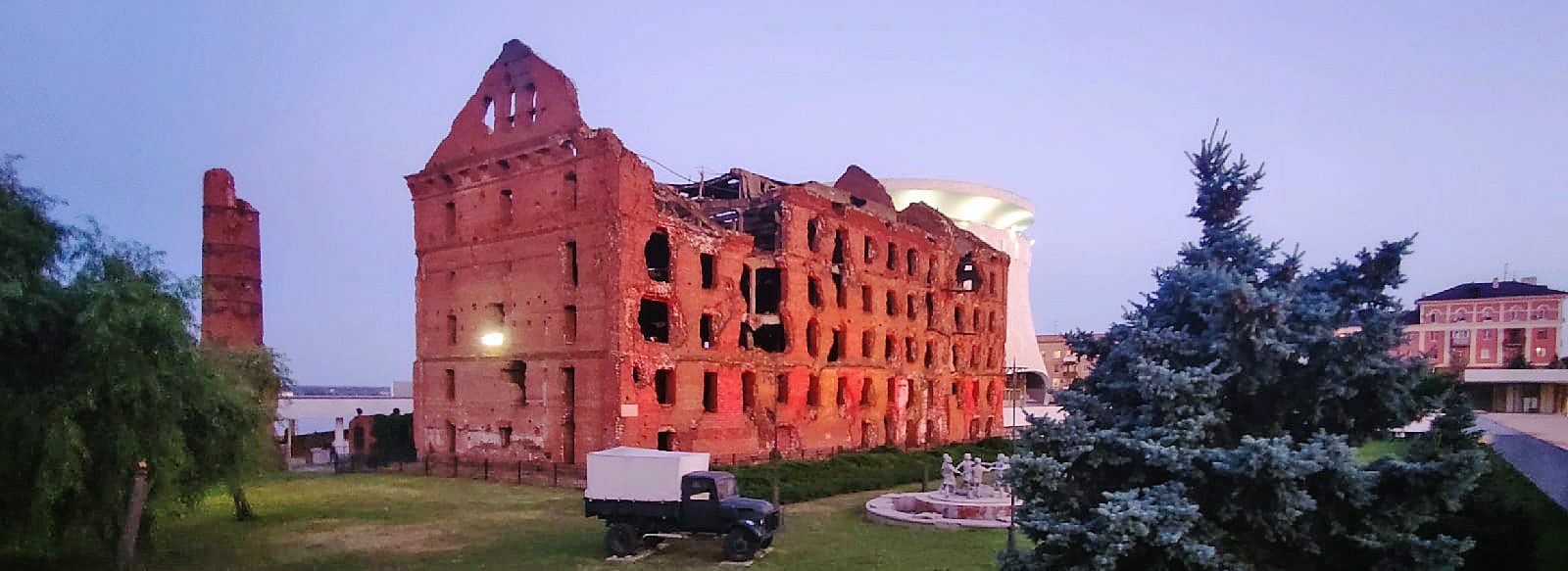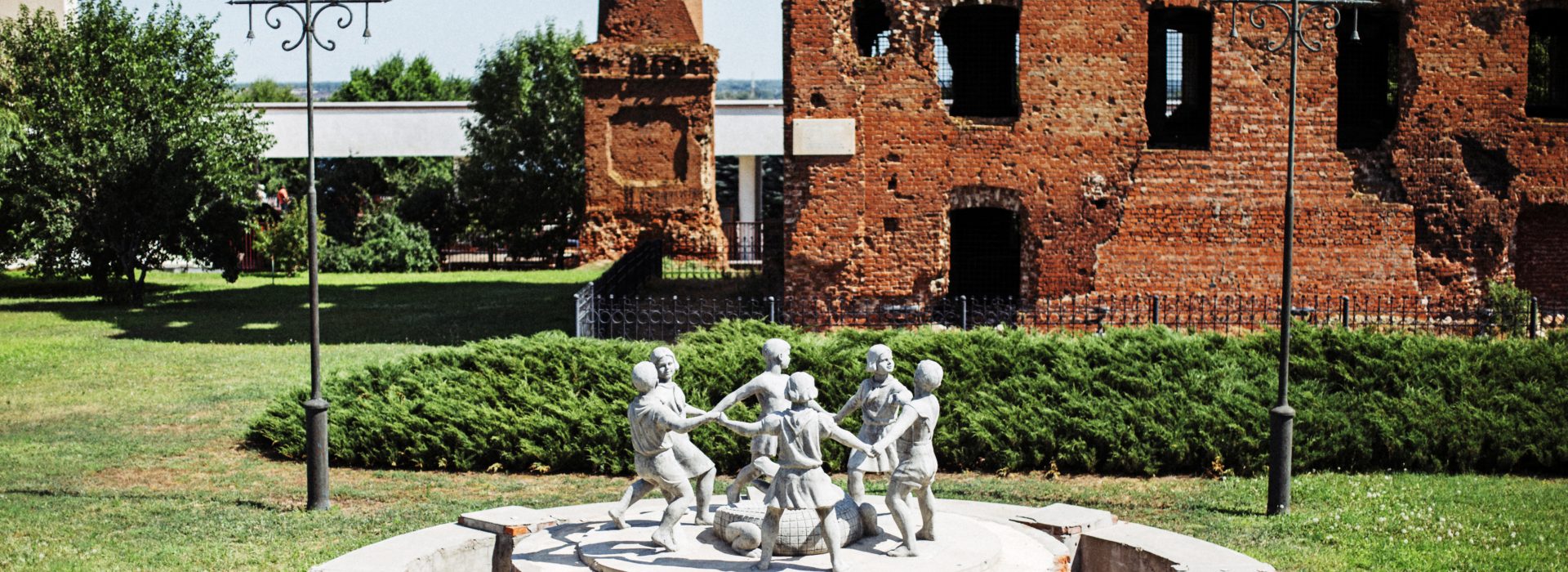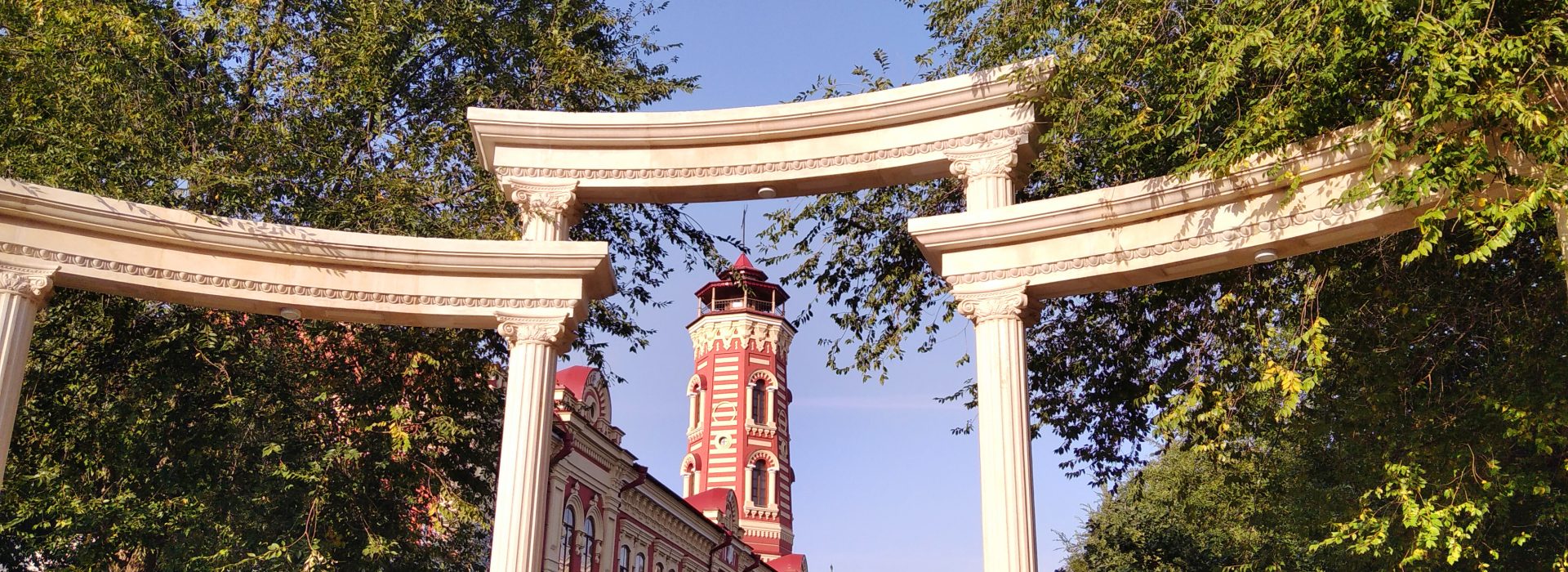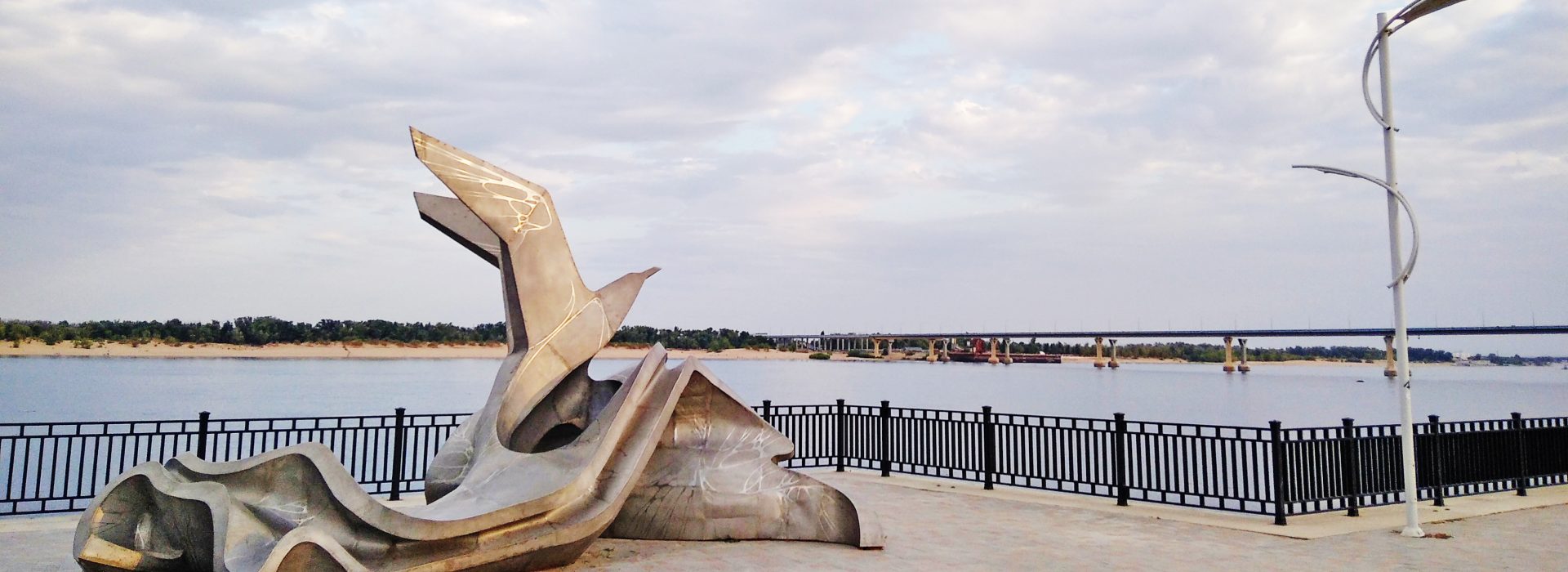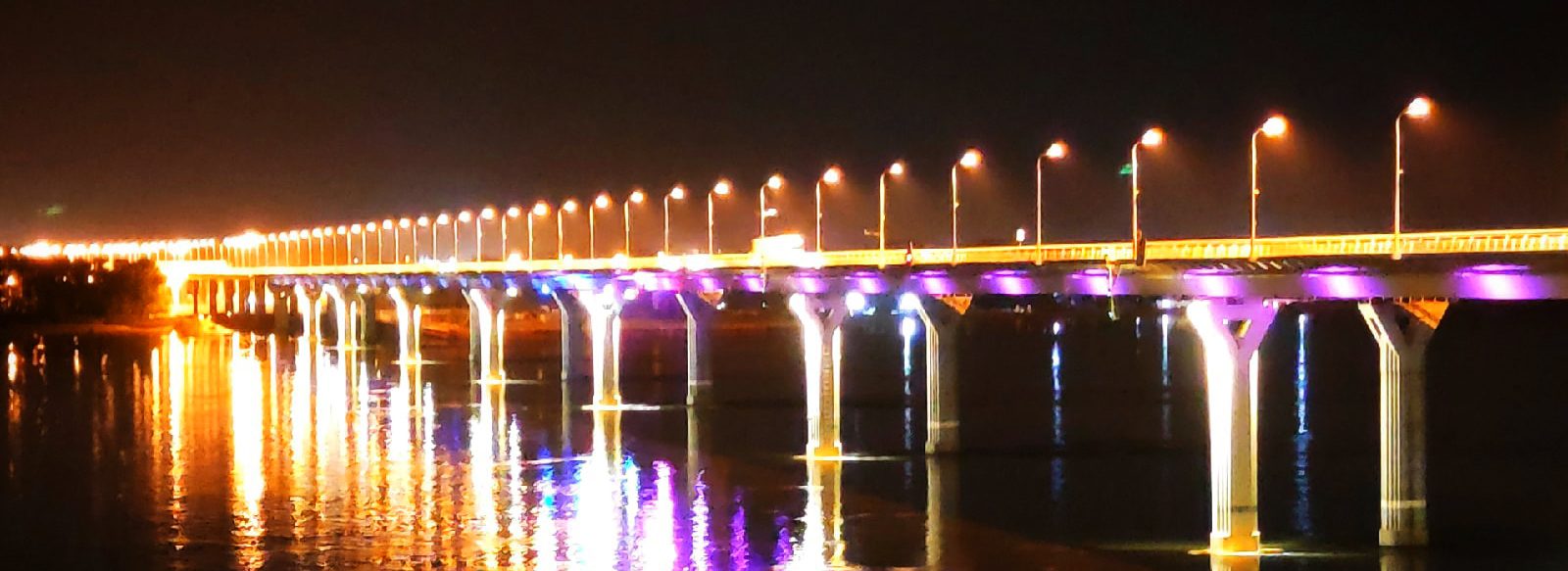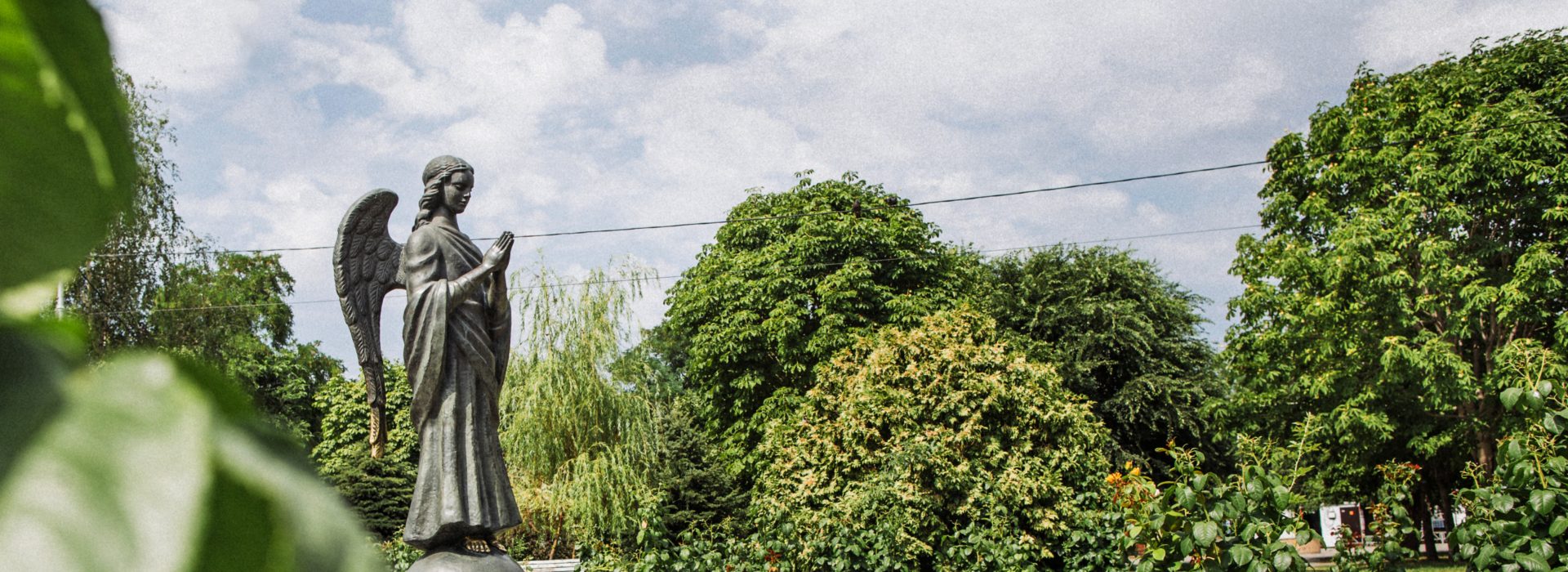Памятник строителям коммунизма
Ул. Николая Отрады
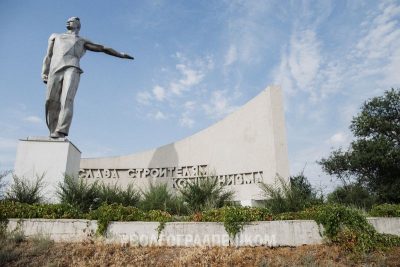 Красавец-комсомолец встречает нас на въезде со стороны Волжской ГЭС в Волгоград. Напротив, через магистраль, установлен знак Золотой Звезды и стела с надписью: «Волгоград — город-герой».
Красавец-комсомолец встречает нас на въезде со стороны Волжской ГЭС в Волгоград. Напротив, через магистраль, установлен знак Золотой Звезды и стела с надписью: «Волгоград — город-герой».
Объект сооружен из алюминия, постамент железобетонный. Высота фигуры — 10 метров, постамента — 5 метров.
На стеле позади монумента надпись: «Слава строителям коммунизма».
Монумент открыт в 1962 г.
Авторы проекта — скульпторы М. С. Альтшулер, И. Д. Бродский, Д. И. Народицкий.
В 1986 году фотография скульптуры попала на страницы журнала L’officiel (№ 728). Известный французский модельер и фотограф Тьерри Мюглер путешествовал по миру, фотографируя моделей на фоне архитектуры и природных чудес. Волгоград вошел в список объектов, привлекших внимание дома моды Тьерри Мюглера и на память волгоградцам остались несколько фэшн-снимков.
Памятник тракторостроителям
Площадь им. Ф. Э. Дзержинского, д. 1
Остановки: 3-я школа, ТРЦ «7 звезд»
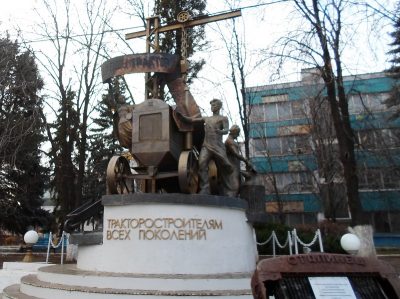 Этот памятник знаком волгоградцам больше по фотографиям, так как находится на территории Тракторного завода, у центральной проходной.
Этот памятник знаком волгоградцам больше по фотографиям, так как находится на территории Тракторного завода, у центральной проходной.
Скульптурную композицию установили 17 июня 2005 г. в честь 75-летия со дня первой победы СТЗ — с конвейера предприятия сошел первый российский трактор СТЗ-1. Это событие положило начало развитию отечественного тракторостроения. Памятник выполнен из бронзы и кованой меди, его высота составляет 6 метров. Автор проекта — народный художник РФ, волгоградский скульптор Виктор Георгиевич Фетисов.
Скульптурная композиция объединила заводчан разных профессий, благодаря которым СТЗ-1 увидел свет: инженер, разработавший проект трактора; каменщица и землекоп, возводившие завод; кузнец, олицетворяющий всю сталелитейную промышленность, наконец; рабочий, непосредственно собравший трактор.
Братская могила моряков
Поселок Водстрой, ул. Костюченко
Остановка: Звезда
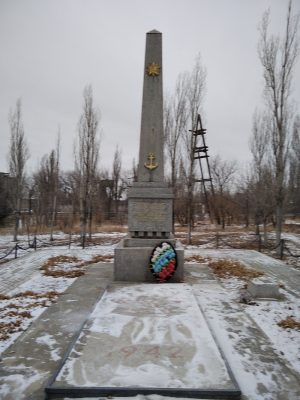 Мемориал расположен в парке рядом с промышленной зоной поселка, который окончательно вошел в границы Тракторозаводского района Волгограда в 2010 году.
Мемориал расположен в парке рядом с промышленной зоной поселка, который окончательно вошел в границы Тракторозаводского района Волгограда в 2010 году.
В августе — сентябре 1942 года на этой территории велись тяжелые оборонительные бои с прорвавшимися к северной окраине города Сталинграда немецко-фашистскими войсками. Для отражения наступления врага был срочно сформирован сводный батальон морской пехоты, в состав которого вошли моряки Волжской военной флотилии. Вместе с другими частями, народным ополчением моряки остановил дальнейшее продвижение противника, отбросив его от Волги.
Памятник над братской могилой моряков сводного батальона Волжской военной флотилии построен по типовому проекту из мраморной крошки. На обелиске текст: «Вечная слава погибшим воинам. Здесь похоронены защитники Сталинграда — моряки Волжской флотилии. Август 1942 года». На обелиске закреплены символы — военный орден и чугунный морской якорь. Рядом имеется мраморная надгробная плита с изображением и надписью «1942», а справа — небольшой постамент, на котором установлена мемориальная гранитная табличка с тестом: «Неизвестному солдату».
Изначально в честь моряков в 1959 году установили мемориальную доску, а в 1972 году мемориал реконструировали, поставив семиметровый обелиск. Благодаря общественной инициативе и благотворительной помощи мемориал в 2012 году после долгого забвения восстановили. Данное событие совпало с 70-летием начала Сталинградской битвы.
Мемориал «Место боев 159-й ударной группы войск 66-й армии 1942–1943 гг.»
Ул. адмирала Ушакова
Остановка: Нижний поселок ВГТЗ
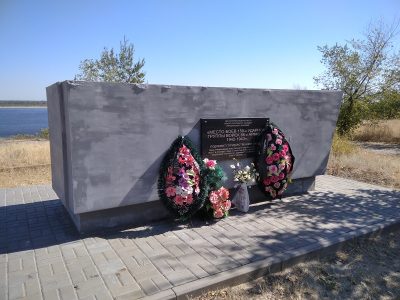 Нижний Тракторный — микрорайон, расположенный в 15 километрах на северо-запад от центра города. Поселок, застроенный преимущественно малоэтажными зданиями, яркий пример соцгородка. Период строительства большинства жилых построек поселка, а также средней школы № 3 и Дворца культуры, 1930-е — 1950-е годы. Есть среди этих зданий те, что простояли все годы Великой Отечественной войны, побывав под обстрелом. Вместе с бойцами регулярной Красной Армии и ополченцами Тракторного завода жители поселка противостояли оккупантам с осени 1942 года. Долгое время защитники Сталинграда покоились в братской могиле на территории поселка.
Нижний Тракторный — микрорайон, расположенный в 15 километрах на северо-запад от центра города. Поселок, застроенный преимущественно малоэтажными зданиями, яркий пример соцгородка. Период строительства большинства жилых построек поселка, а также средней школы № 3 и Дворца культуры, 1930-е — 1950-е годы. Есть среди этих зданий те, что простояли все годы Великой Отечественной войны, побывав под обстрелом. Вместе с бойцами регулярной Красной Армии и ополченцами Тракторного завода жители поселка противостояли оккупантам с осени 1942 года. Долгое время защитники Сталинграда покоились в братской могиле на территории поселка.
В память о них, по заказу Волгоградского тракторного завода к 25-летию разгрома немецких войск под Сталинградом создали памятник с автоматом. Автор алебастровой скульптуры — волгоградский скульптор Юрий Раков. Памятник установили 2 февраля 1968 году. Так благодарные потомки увековечили память о 159-й ударной группе 66-й армии Донского фронта, защищавшей Тракторный завод.
От этого памятника остался только серый постамент. На табличке черного цвета надпись: «Достопримечательное место. Объект культурного наследия регионального значения. Место боев 159-й ударной группы войск 66-й армии 1942—1943 гг.». Памятник визуально размещен в конце центральной аллеи, начинающейся от входа Дворца культуры через запущенный парк до берега Волги.
Примечательно, что на обоих сторонах постамента долгое время были изображены граффити — простые рисунки и текст печатными буквами, сделанные от руки. Трогательная попытка передать сведения о погибших. Так местные жители пытались сохранить память не только о бойцах регулярной армии, но и об ополченцах — заводчанах и других мирных сталинградцах, захороненных в братской могиле рядом. После перезахоронения останков из братской могилы в 2017 году постамент реконструировали и уникальные граффити исчезли.
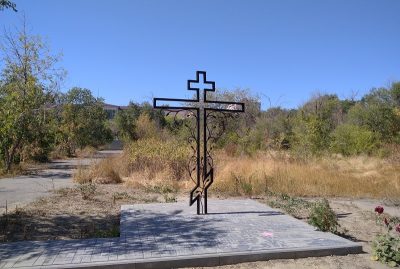 В июне 2019 года установили поклонный крест ополченцам, погибшим в 1942 году. Его расположили на той же аллее между ДК и постаментом на берегу Волги. Жители перенесли исчезнувший текст с постамента памятника на брусчатку рядом с крестом.
В июне 2019 года установили поклонный крест ополченцам, погибшим в 1942 году. Его расположили на той же аллее между ДК и постаментом на берегу Волги. Жители перенесли исчезнувший текст с постамента памятника на брусчатку рядом с крестом.
Место памяти, кроме прочего, посещают кадеты известного учебного заведения — Кадетского корпуса Следственного комитета Российской Федерации им. Ф. Ф. Слипченко (бывший педагогический лицей). Данное учебное заведение расположено рядом с мемориалом на ул. Тракторостроителей, д. 1А. На его территории находится мемориальный знак — танковая башня. До 1995 г. башня находилась у устья реки Мокрая Мечетка (между поселками Спартановка и Нижний Тракторный). Надпись на постаменте: «Здесь героически сражались 124 и 149 стрелковые бригады и другие части 62-й Армии. Август 1942 — январь 1943 г.». На том же постаменте расположили мемориальную доску: «20.04.1995 г. В ознаменовании 50-летия Победы советского народа над фашизмом ветераны воины, педагоги и лицеисты заложили капсулу с обращением к потомкам. Вскрыть 20.04.2045 в год 100-летия Победы».
В одном из корпусов учебного заведения с 1970 года работает народный музей боевой и трудовой славы тракторозаводцев. В его состав входят пять залов: главный зал, диорама «Оборона Сталинграда на северных рубежах», комната Маршала Советского Союза, дважды Героя Советского Союза В. И. Чуйкова, триумфальный зал, зал истории учебного заведения. Примечательно, что диораму школьного музея создавали те же художники, которые работали над панорамой «Сталинградская битва». А в экспозиции музея много подлинных предметов. Например, в 1983 году семья В. И. Чуйкова передала личные вещи командарма Сталинграда.
Мемориал Нижнего Тракторного не единственный памятник, увековечивающий память о подвиги ополченцев Сталинграда.
Обелиск ополченцам СТЗ
Тракторозаводский район, проспект им. В. И. Ленина
Остановка: Механический институт
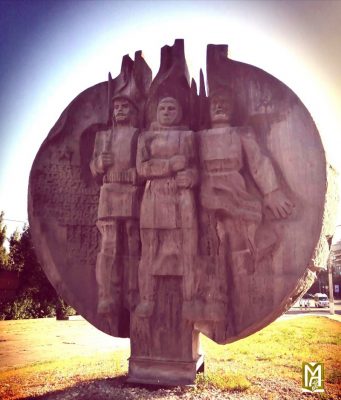 Обелиск представляет собой двухсторонний медальон, памятный знак в честь рабочих-ополченцев Сталинградского тракторного завода. Кованный круглой формы мемориал открыт на проспекте им. В. И. Ленина 01.02.1983. Одна сторона обелиска включает три фигуры ополченцев (центральная женщины с винтовой через плечо), другая — ряд танков, вставших на защиту Тракторного района. Авторы проекта — скульптор Роберт Петрович Харитонов и архитектор Геннадий Михайлович Коваленко.
Обелиск представляет собой двухсторонний медальон, памятный знак в честь рабочих-ополченцев Сталинградского тракторного завода. Кованный круглой формы мемориал открыт на проспекте им. В. И. Ленина 01.02.1983. Одна сторона обелиска включает три фигуры ополченцев (центральная женщины с винтовой через плечо), другая — ряд танков, вставших на защиту Тракторного района. Авторы проекта — скульптор Роберт Петрович Харитонов и архитектор Геннадий Михайлович Коваленко.
______________________________________________________________________________________________________
The monument to communism’s builders
Nikolai Othady street
 The handsome Komsomol Member meets us at the entrance from Volga hydroelectric power station to Volgograd. Opposite, across the highway, there is a Golden Star sign and a stele with the inscription: «Volgograd is a hero city».
The handsome Komsomol Member meets us at the entrance from Volga hydroelectric power station to Volgograd. Opposite, across the highway, there is a Golden Star sign and a stele with the inscription: «Volgograd is a hero city».
The object is made with aluminium, the base – with reinforced concrete. The height of the figure is 10 meters, the base — 5 meters.
On the opposite side of the base there is the inscription: Glory to communism’s builders”..
The monument was opened in 1962.
The authors of the project were sculptors M. S. Altshuler, I. D. Brodsky, D. I. Naroditsky.
In 1986 the photo with the sculpture appeared in L’officiel magazine (№ 728). The famous French fashion designer and photographer Thierry Mugler traveled around the world, took photos of models against the backdrop of architecture and natural wonders. Volgograd was included in the list of the must see objects and attracted the attention of the Thierry Mugler’s fashion house.
The monument to tractor builders
F.E Dzerzhinsky square, 1
Tret’ya shkola, Shopping Mall «Seven Stars»
 The most part of Volgograd’s residents saw this monument only on the photos, because it is located on the territory of the Tractor Plant, at the central checkpoint.
The most part of Volgograd’s residents saw this monument only on the photos, because it is located on the territory of the Tractor Plant, at the central checkpoint.
The sculptural composition was installed on the 17th of June, 2005 in honor of the 75th anniversary of the first victory of the STZ-the first Russian tractor STZ — 1 came off the assembly line of the enterprise. This event marked the beginning of the development of domestic tractor construction. The monument is made of bronze and forged copper, its height is 6 meters. The author of the project is the People’s Artist of the Russian Federation, Volgograd sculptor Viktor Georgievich Fetisov.
The sculptural composition united workers of different professions, thanks to which STZ-1 was released: the engineer, who developed the tractor project; a bricklayer and an excavator, who built the plant; the blacksmith, personifying the entire steel industry, finally; a worker, who directly assembled a tractor.
The communal grave of sailors
Settlement Vodstroy, Kostyuchenko Street
Stop: Zvezda
 The memorial is situated in the park near the industrial zone of the settlement, that finally entered into the Traktorozavodsky district of Volgograd in 2010.
The memorial is situated in the park near the industrial zone of the settlement, that finally entered into the Traktorozavodsky district of Volgograd in 2010.
In August — September 1942, heavy defensive battles were fought on this territory with the German fascist troops that had broken through to the northern outskirts of the city of Stalingrad. To repel the enemy offensive, a combined battalion of the marines was urgently formed, which included the sailors of the Volga military flotilla. Together with other units, the people’s militia, the sailors stopped the further advance of the enemy, throwing him away from the Volga.
The monument over the common grave of the sailors of the combined battalion of the Volga military flotilla was built according to a standard design from marble chips. On the obelisk there is a text: “Eternal glory to the fallen soldiers. The defenders of Stalingrad, the sailors of the Volga flotilla, are buried here. August 1942 «. Symbols are fixed on the obelisk — a military order and a cast-iron sea anchor. Nearby there is a marble tombstone with the image and the inscription «1942», and on the right is a small pedestal on which a memorial granite plaque with the test: «To the Unknown Soldier»is installed.
Initially, a memorial plaque was erected in honor of the sailors in 1959, and in 1972 the memorial was reconstructed with a seven-meter obelisk. Thanks to the public initiative and charitable assistance, the memorial was restored in 2012 after a long oblivion. This event coincided with the 70th anniversary of the beginning of the Battle of Stalingrad.
MEMORIAL «PLACE OF BATTLES OF THE 159TH ATTACK GROUP OF TROOPS OF THE 66TH ARMY IN 1942-1943.»
Admiral Ushakov street
Stop: Nizhny poselok VGTZ
 Nizhny Traktorny is a microdistrict located 15 kilometers northwest of the city center. The settlement, built up mainly with low-rise buildings, is a vivid example of a social town. The period of construction of most of the residential buildings in the settlement, as well as secondary school No. 3 and the Palace of Culture, are 1930s — 1950s. Among these buildings there are those that stood all the years of the Great Patriotic War, having been under fire. Together with the soldiers of the regular Red Army and the militia of the Tractor Plant, the inhabitants of the village resisted the invaders since the fall of 1942. For a long time, the defenders of Stalingrad rested in a mass grave on the territory of the settlement.
Nizhny Traktorny is a microdistrict located 15 kilometers northwest of the city center. The settlement, built up mainly with low-rise buildings, is a vivid example of a social town. The period of construction of most of the residential buildings in the settlement, as well as secondary school No. 3 and the Palace of Culture, are 1930s — 1950s. Among these buildings there are those that stood all the years of the Great Patriotic War, having been under fire. Together with the soldiers of the regular Red Army and the militia of the Tractor Plant, the inhabitants of the village resisted the invaders since the fall of 1942. For a long time, the defenders of Stalingrad rested in a mass grave on the territory of the settlement.
In memory of them, by order of the Volgograd Tractor Plant, a monument with a machine gun was created for the 25th anniversary of the defeat of German troops at Stalingrad. The author of the alabaster sculpture is the Volgograd sculptor Yuri Rakov. The monument was erected on February 2, 1968. This is how grateful descendants immortalized the memory of the 159th Shock Group of the 66th Army of the Don Front, which defended the Tractor Plant.
Only a gray pedestal remained of this monument. There is an inscription on the black plate: “Interesting place. A cultural heritage site of regional significance. Place of battles of the 159th shock group of troops of the 66th army in 1942-1943.». The monument is visually placed at the end of the central alley starting from the entrance of the Palace of Culture through the neglected park to the Volga bank.
Notably, that for a long time graffiti was depicted on both sides of the pedestal — simple drawings and text in block letters, made by hand. A touching attempt to convey information about the victims. So the local residents tried to preserve the memory not only of the soldiers of the regular army, but also of the militias — factory workers and other peaceful Stalingraders buried in a mass grave nearby. After the reburial of the remains from the mass grave in 2017, the pedestal was reconstructed and the unique graffiti disappeared.
 In June, 2019, a veneration cross was erected to the militias who died in 1942. It was located on the same alley between the recreation center and the pedestal on the Volga bank. Residents transferred the disappeared text from the pedestal of the monument to the paving stones next to the cross.
In June, 2019, a veneration cross was erected to the militias who died in 1942. It was located on the same alley between the recreation center and the pedestal on the Volga bank. Residents transferred the disappeared text from the pedestal of the monument to the paving stones next to the cross.
The place of memory, among other things, is visited by cadets of a well-known educational institution — the Cadet Corps of the Investigative Committee of the Russian Federation. FF Slipchenko (former of the pedagogical lyceum). This educational institution is located next to the memorial on the street. Traktorostroiteley, 1A. On its territory there is a memorial sign —a tank tower. Until 1995, the tower was located at the mouth of the Mokraya Mechetka River (between the villages of Spartanovka and Nizhny Traktorny). The inscription on the pedestal: “The 124th and 149th rifle brigades and other parts of the 62nd Army heroically fought here. August 1942 — January 1943 «. A memorial plaque was placed on the same pedestal: 20.04.1995. In commemoration of the 50th anniversary of the Victory of the Soviet people over fascism, war veterans, teachers and lyceum students laid a capsule with an appeal to descendants. Open 20.04.2045 in the year of the 100th anniversary of the Victory «..
Since 1970, in one of the buildings of the educational institution the people’s museum of military and labor glory of tractor plant workers has been working.. It consists of five halls: the main hall, the diorama «The Defense of Stalingrad on the Northern Frontiers», the room of the Marshal of the Soviet Union, twice Hero of the Soviet Union V.I. Chuikov, the triumphal hall, the history hall of the educational institution. Remarably, that the diorama of the school museum was created by the same artists who worked on the panorama «Battle of Stalingrad». And in the museum’s exposition there are many genuine items. For example, in 1983 the family of V.I. Chuikov handed over the personal belongings of the commander of Stalingrad.
The Nizhny Traktorny Memorial is not the only monument that perpetuates the memory of the exploits of the militia of Stalingrad.
OBELISK TO THE MILITIA OF STZ
Traktorozavodsky district, V. I. Lenin’s avenue
Stop: Mekhanicheskiy institute
 The obelisk is a double-sided medallion, a memorial sign in honor of the militia workers of the Stalingrad Tractor Plant. The round forged memorial was opened on V.I. Lenin 02.01.1983. One side of the obelisk includes three figures of the militia (the central woman with a screw over her shoulder), the other — a row of tanks that stood up to defend the Tractor District. The authors of the project are the sculptor Robert Petrovich Kharitonov and the architect Gennady Mikhailovich Kovalenko.
The obelisk is a double-sided medallion, a memorial sign in honor of the militia workers of the Stalingrad Tractor Plant. The round forged memorial was opened on V.I. Lenin 02.01.1983. One side of the obelisk includes three figures of the militia (the central woman with a screw over her shoulder), the other — a row of tanks that stood up to defend the Tractor District. The authors of the project are the sculptor Robert Petrovich Kharitonov and the architect Gennady Mikhailovich Kovalenko.
